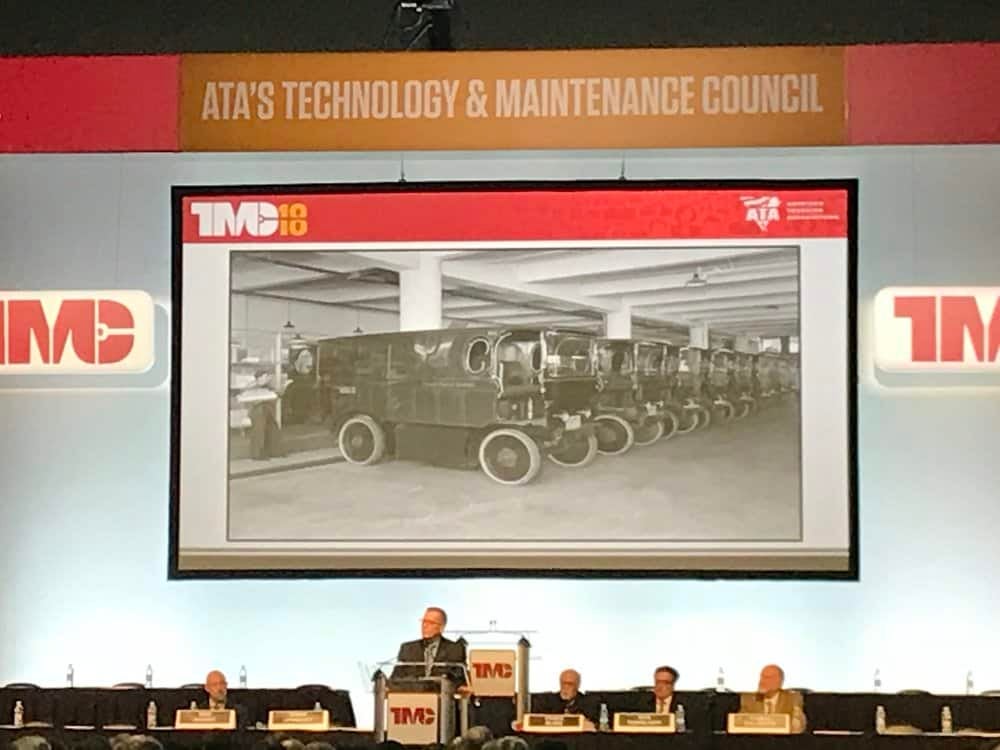At the TMC 18 conference in Atlanta industry experts from Daimler (Chuck Blake), Mercedes-Benz Vans (Nick Tempelhoff), Penske (Mike Hasinec), Cummins (Thomas Dollmeyer), and UPS (Duane Lippincott) discuss fleet maintenance management in our evolving commercial freight ecosystem.
The problem with moving forward, according to Hasinec, is the limited OEM options. “They need to be better,” he says. “The problem is owners and operators who are not willing to invest on a large scale.”
Penske already has to be “all things to all people,” he says. “We look for where the opportunities lie.”
“Investing in these things requires infrastructure, but it also requires maintenance. We need consistency, and one of those areas lies with our good ol’ friend, the government,” says Hasinec.
With governmental oversight comes regulations and from regulations comes consistency. For their part, governments [be they federal or state or local] also need to get financial backing, and to support early adopters.
Lippincott from UPS notes that they currently use 9,000 different vehicles in their fleets today, but the biggest issue the industry faces is fear. “You can look at fear in one of two ways,” he says. “Forget Everything And Run, or Face Everything And Rise.”

Shops and equipment are already making modifications. For alternative fuel like LNG, CNG, propane, hybrid and electric, we mostly have infrastructure in place or at least rapidly advancing. Hydrogen is on the horizon, but Electric Class 8 we just don’t know yet.
“The economics in cities and city delivery applications are good and stand to continue to be that way,” says Dollmeyer. “City buses stand to increase distribution through 2020. The powertrains for these requests from cities to clean things up is growing.”
Long haul, on the other hand, is up for debate, according to Dollmeyer. Currently, there is great uncertainty from various sectors in the industry. “Some are strongly positive and some are just as strongly negative,” he says. These contrasting positions will have to be worked out before we see aggressive change here.
What’s drives the changes? Total cost of ownership (TCO), regulation, infrastructure and feasibility (do the machines actually work better than the previous generation?). The question becomes how do you add the new while keeping the current. The internal combustion engine isn’t going anywhere anytime soon. So, what we’re going to see are more hybrids. There will also be battery electric vehicles (BEVs) and fuel-cell electric vehicles (FCEVs). BEVs are more feasible from a maintenance point of view. FCEVs carry more energy than BEVs.
“You can look at fear in one of two ways: Forget Everything And Run, or Face Everything And Rise.”
As far as regulation goes, some cities are about to require zero emissions and the industry has to figure out manufacturing outside the city as well as the vehicles that live inside the city. The leading truck segments for electric are drayage, utility, regional distribution (class 8), urban delivery (class 6-7), refuse (class 7-8) and line haul (class 8).
As this begins to develop we have to think about the infrastructure challenges. Charging takes power and time. CVs need between .8 and 2.5 wh/mi. Batteries range from 50-500 kWh. Local chargers are available from 2 to 90 kW. Each vehicle has a rate limit. Fast chargers exist but are limited. “Above 10 kW AC charging is 3-phase territory,” says Dollmeyer.
Many report that real estate is a big priority. Also electricity charging stations and parking lots are not often together. Also, we can expect very high rates to be coming, perhaps slowly, but also steadily as standardization grows.
The good news about BEVs is there is less maintenance required. There are fewer fluids, longer intervals between upkeep, fewer parts to break, to leak, or get loose. Hybrids, by contrast, are added systems. That means more exposure. The final outcomes of how the hybrid’s integrated systems function vary greatly.
The training and safety will be around the issues of diagnostics, prognostics and self-healing.
How hard will the new types of vehicles be to learn? “Not as hard as they were to design and create, but there will be dangers and challenges in new ways,” says Dollmeyer.
The ability of data to offer predictive analytics and to anticipate maintenance, and possibly at the highest level even to use that data to “self-heal,” are the main goals for maintenance application.
What we need is “just in time” training with each new roll out. “Personally, I think this is something we struggle with as an industry,” says Lippincott.
“We must learn faster,” he says. “The S curves are speeding up. By overcoming fear we can skip entire S’s. We need to be proactive. Educate ourselves, just like we’re doing right here, right now. Listen and learn. What’s the future near and far going to look like?”

Stay up-to-date with the latest commentary and insights on FreightTech and the impact to the markets by subscribing.







